Citroen C4 AIRCROSS 2017 1.G Owner's Manual
Manufacturer: CITROEN, Model Year: 2017, Model line: C4 AIRCROSS, Model: Citroen C4 AIRCROSS 2017 1.GPages: 368, PDF Size: 11.54 MB
Page 171 of 368
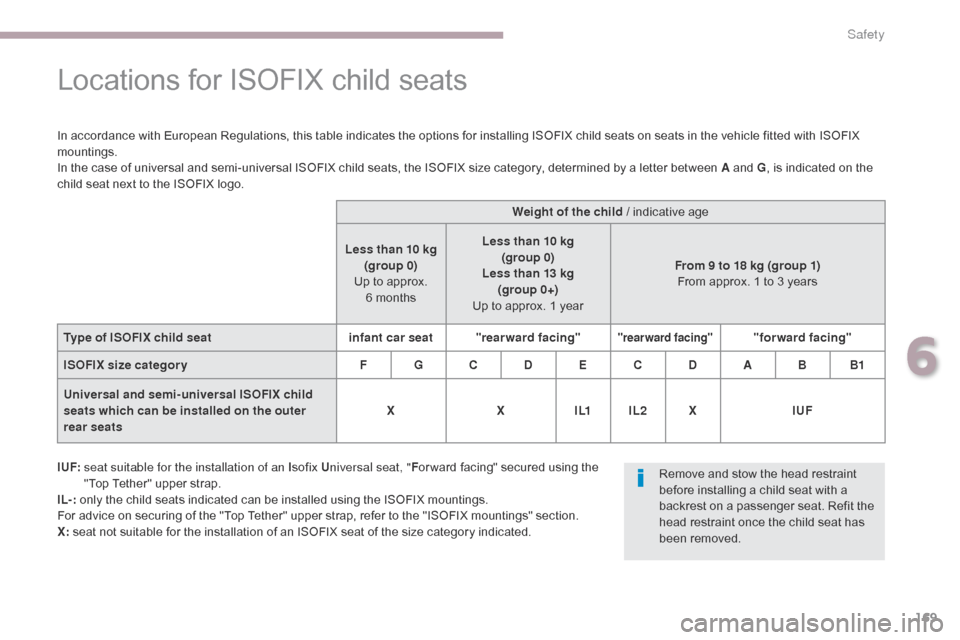
169
C4-Aircross_en_Chap06_securite_ed01-2016
Locations for ISOFIX child seats
In accordance with European Regulations, this table indicates the options for installing ISOFIX child seats on seats in the vehicle fitted with ISOFIX
mountings.
In the case of universal and semi-universal ISOFIX child seats, the ISOFIX size category, determined by a letter between A and G, is indicated on the
child seat next to the ISOFIX logo.
Weight of the child / indicative age
Less than 10 kg (group 0)
Up to approx. 6
monthsLess than 10 kg
(group 0)
Less than 13 kg
(group 0+)
Up to approx. 1 year From 9 to 18 kg (group 1)
From approx. 1 to 3 years
Type of ISOFIX child seat infant car seat "rearward facing"
"rearward facing""forward facing"
ISOFIX size categor y F G C D E C D A B B1
Universal and semi-universal ISOFIX child
seats which can be installed on the outer
rear seat s X
XI L1IL2 X IUF
I UF:
s
eat suitable for the installation of an I sofix Universal seat, " For ward facing" secured using the
"Top Tether" upper strap.
IL-:
o
nly the child seats indicated can be installed using the ISOFIX mountings.
For advice on securing of the "Top Tether" upper strap, refer to the "ISOFIX mountings" section.
X: seat not suitable for the installation of an ISOFIX seat of the size category indicated. Remove and stow the head restraint
before installing a child seat with a
backrest on a passenger seat. Refit the
head restraint once the child seat has
been removed.
6
Safety
Page 172 of 368
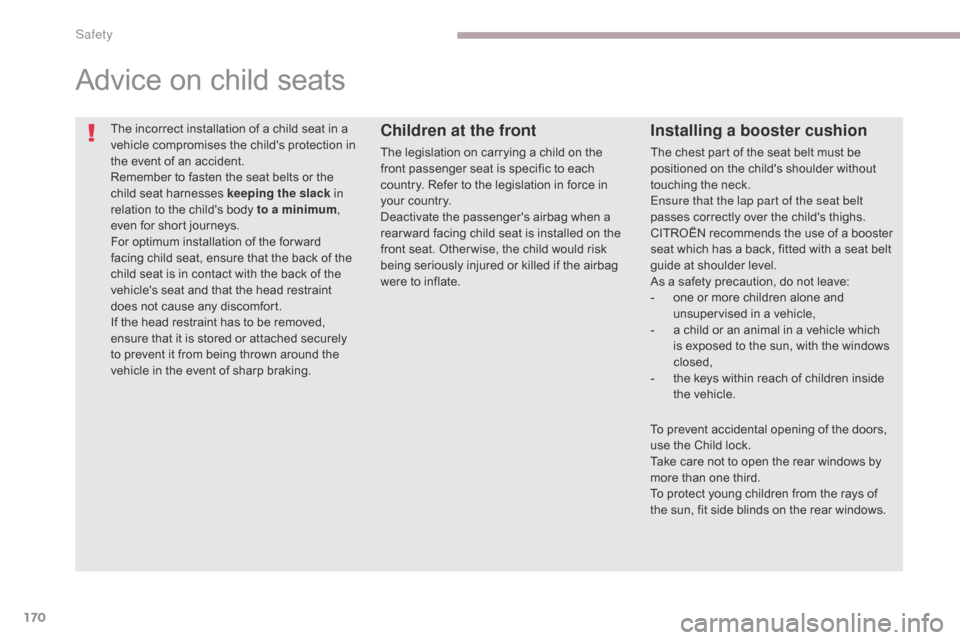
170
C4-Aircross_en_Chap06_securite_ed01-2016
The incorrect installation of a child seat in a
vehicle compromises the child's protection in
the event of an accident.
Remember to fasten the seat belts or the
child seat harnesses keeping the slack in
relation to the child's body to a minimum,
even for short journeys.
For optimum installation of the for ward
facing child seat, ensure that the back of the
child seat is in contact with the back of the
vehicle's seat and that the head restraint
does not cause any discomfort.
If the head restraint has to be removed,
ensure that it is stored or attached securely
to prevent it from being thrown around the
vehicle in the event of sharp braking.
Advice on child seats
Installing a booster cushion
The chest part of the seat belt must be
positioned on the child's shoulder without
touching the neck.
Ensure that the lap part of the seat belt
passes correctly over the child's thighs.
CITROËN recommends the use of a booster
seat which has a back, fitted with a seat belt
guide at shoulder level.
As a safety precaution, do not leave:
-
o
ne or more children alone and
unsupervised in a vehicle,
-
a c
hild or an animal in a vehicle which
is exposed to the sun, with the windows
closed,
-
t
he keys within reach of children inside
the vehicle.
Children at the front
The legislation on carrying a child on the
front passenger seat is specific to each
country. Refer to the legislation in force in
your country.
Deactivate the passenger's airbag when a
rear ward facing child seat is installed on the
front seat. Other wise, the child would risk
being seriously injured or killed if the airbag
were to inflate.
To prevent accidental opening of the doors,
use the Child lock.
Take care not to open the rear windows by
more than one third.
To protect young children from the rays of
the sun, fit side blinds on the rear windows.
Safety
Page 173 of 368
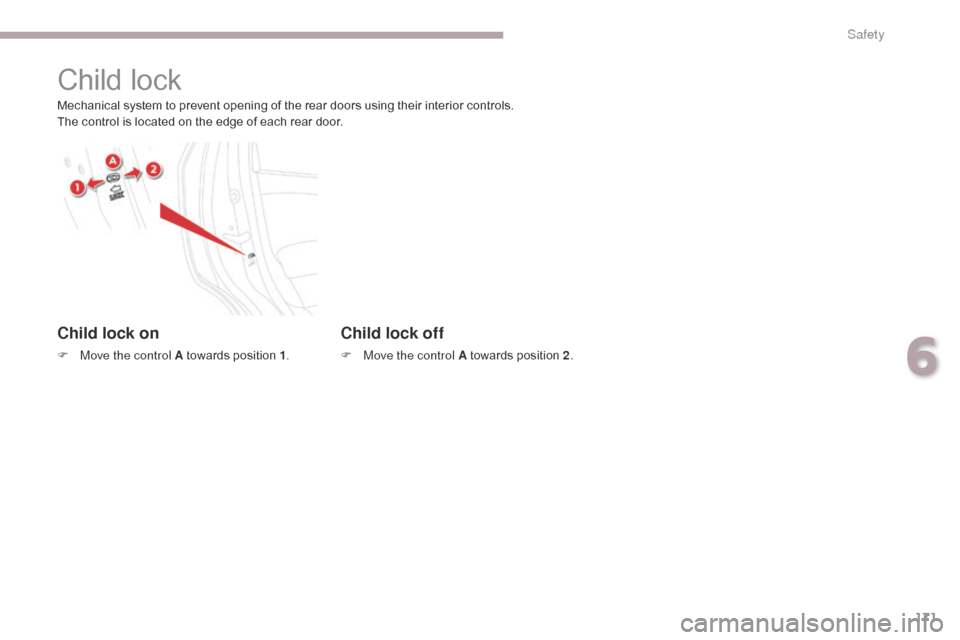
171
C4-Aircross_en_Chap06_securite_ed01-2016
Child lock
Mechanical system to prevent opening of the rear doors using their interior controls.
The control is located on the edge of each rear door.
Child lock on
F Move the control A towards position 1.
Child lock off
F Move the control A towards position 2 .
6
Safety
Page 174 of 368
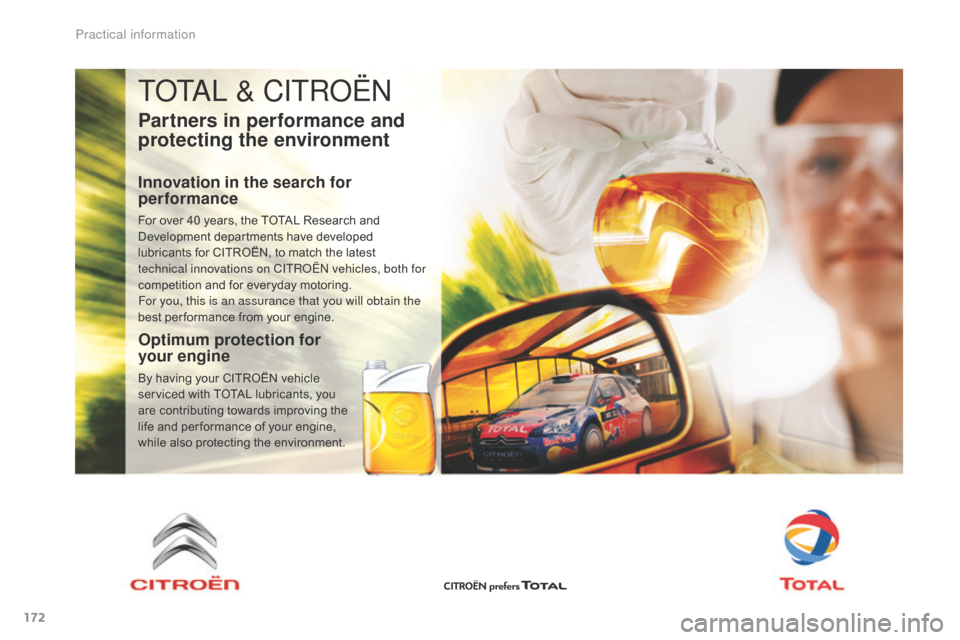
172
C4-Aircross_en_Chap07_info-pratiques_ed01-2016
TOTAl & CITROËN
Partners in performance and
protecting the environment
Innovation in the search for
performance
For over 40 years, the TOTAL Research and
Development departments have developed
lubricants for CITROËN, to match the latest
technical innovations on CITROËN vehicles, both for
competition and for everyday motoring.
For you, this is an assurance that you will obtain the
best per formance from your engine.
Optimum protection for
your engine
By having your CITROËN vehicle
serviced with TOTAL lubricants, you
are contributing towards improving the
life and per formance of your engine,
while also protecting the environment.
Practical information
Page 175 of 368
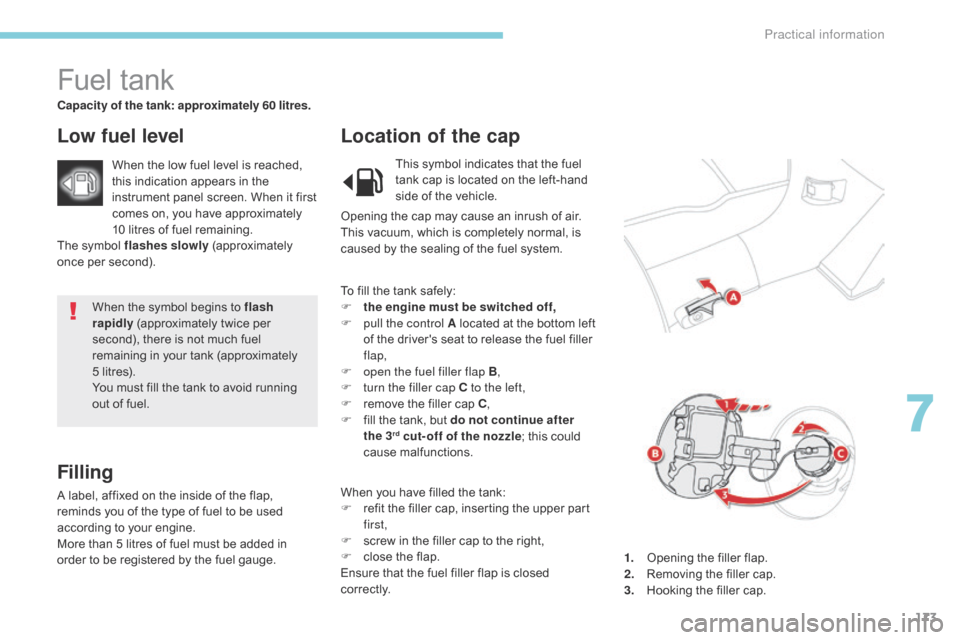
173
C4-Aircross_en_Chap07_info-pratiques_ed01-2016
When the symbol begins to flash
rapidly (approximately twice per
second), there is not much fuel
remaining in your tank (approximately
5
litres).
You must fill the tank to avoid running
out of fuel.
Fuel tank
Capacity of the tank: approximately 60 litres.
Low fuel level
Filling
A label, affixed on the inside of the flap,
reminds you of the type of fuel to be used
according to your engine.
More than 5 litres of fuel must be added in
order to be registered by the fuel gauge.
Location of the cap
When the low fuel level is reached,
this indication appears in the
instrument panel screen. When it first
comes on, you have approximately
10 litres of fuel remaining.
The symbol flashes slowly (approximately
once per second).
1.
O
pening the filler flap.
2.
R
emoving the filler cap.
3.
H
ooking the filler cap.
To fill the tank safely:
F
t
he engine must be switched off,
F
p
ull the control A located at the bottom left
of the driver's seat to release the fuel filler
flap,
F
o
pen the fuel filler flap B,
F
t
urn the filler cap C to the left,
F
r
emove the filler cap C,
F
f
ill the tank, but do not continue after
the
3
rd cut- off of the nozzle; this could
cause malfunctions.
When you have filled the tank:
F
r
efit the filler cap, inserting the upper part
first,
F
s
crew in the filler cap to the right,
F
c
lose the flap.
Ensure that the fuel filler flap is closed
c o r r e c t l y. This symbol indicates that the fuel
tank cap is located on the left-hand
side of the vehicle.
Opening the cap may cause an inrush of air.
This vacuum, which is completely normal, is
caused by the sealing of the fuel system.
7
Practical information
Page 176 of 368
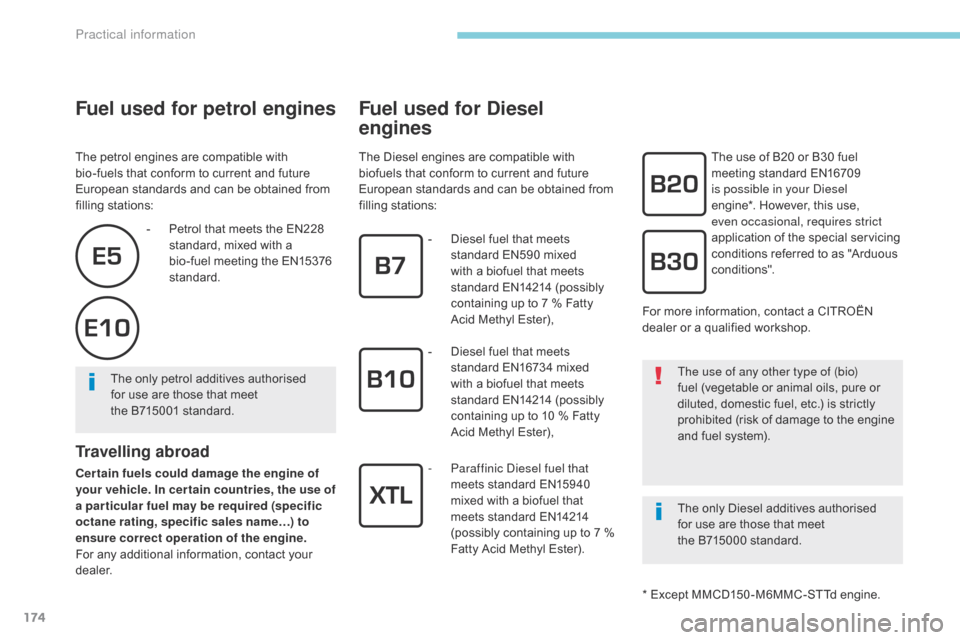
174
C4-Aircross_en_Chap07_info-pratiques_ed01-2016
Fuel used for petrol engines
The petrol engines are compatible with
bio-fuels that conform to current and future
European standards and can be obtained from
filling stations:
Travelling abroad
Cer tain fuels could damage the engine of
your vehicle. In cer tain countries, the use of
a par ticular fuel may be required (specific
octane rating, specific sales name…) to
ensure correct operation of the engine.
For any additional information, contact your
dealer.-
Pe
trol that meets the EN228
standard, mixed with a
bio-fuel meeting the EN15376
standard.
The only petrol additives authorised
for use are those that meet
the B715001 standard.
Fuel used for Diesel
engines
The Diesel engines are compatible with
biofuels that conform to current and future
European standards and can be obtained from
filling stations: The use of B20 or B30 fuel
meeting standard EN16709
is possible in your Diesel
engine*. However, this use,
even occasional, requires strict
application of the special servicing
conditions referred to as "Arduous
conditions".
-
D
iesel fuel that meets
standard EN590 mixed
with a biofuel that meets
standard
EN14214 (possibly
containing up to 7 % Fatty
Acid Methyl Ester),
-
D
iesel fuel that meets
standard EN16734 mixed
with a biofuel that meets
standard
EN14214 (possibly
containing up to 10 % Fatty
Acid Methyl Ester),
-
P
araffinic Diesel fuel that
meets standard EN15940
mixed with a biofuel that
meets standard EN14214
(possibly containing up to 7 %
Fatty Acid Methyl Ester). For more information, contact a CITROËN
dealer or a qualified workshop.
The use of any other type of (bio)
fuel (vegetable or animal oils, pure or
diluted, domestic fuel, etc.) is strictly
prohibited (risk of damage to the engine
and fuel system).
The only Diesel additives authorised
for use are those that meet
the B715000 standard.
* Except MMCD150 -M6MMC-STTd engine.
Practical information
Page 177 of 368
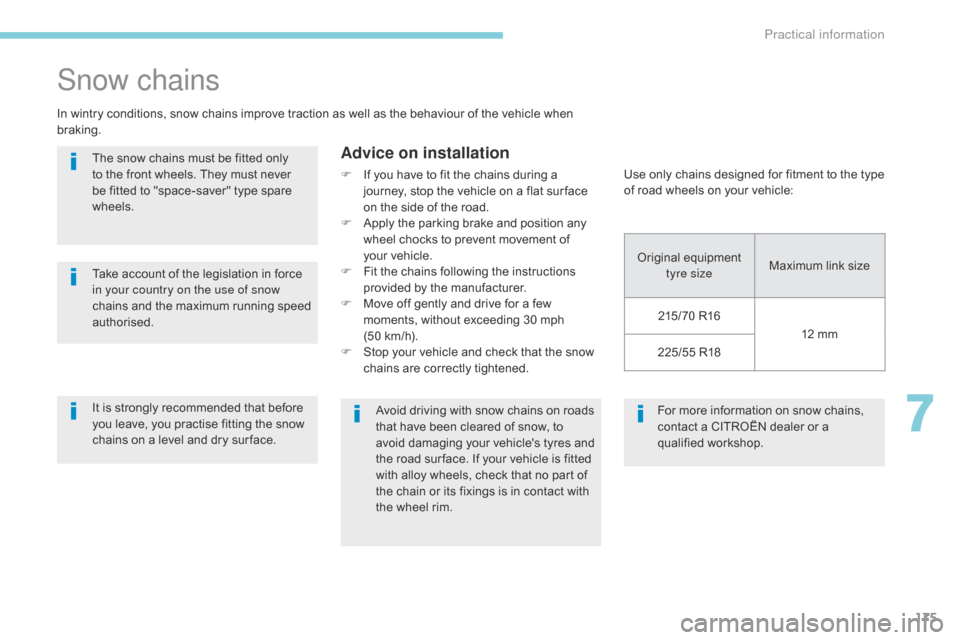
175
C4-Aircross_en_Chap07_info-pratiques_ed01-2016
For more information on snow chains,
contact a CITROËN dealer or a
qualified workshop.
Snow chains
In wintry conditions, snow chains improve traction as well as the behaviour of the vehicle when
braking.
Advice on installation
F If you have to fit the chains during a journey, stop the vehicle on a flat sur face
on the side of the road.
F
A
pply the parking brake and position any
wheel chocks to prevent movement of
your
vehicle.
F
F
it the chains following the instructions
provided by the manufacturer.
F
M
ove off gently and drive for a few
moments, without exceeding 30 mph
(50 km/h).
F
S
top your vehicle and check that the snow
chains are correctly tightened.
The snow chains must be fitted only
to the front wheels. They must never
be fitted to "space-saver" type spare
wheels.
Take account of the legislation in force
in your country on the use of snow
chains and the maximum running speed
authorised.
Avoid driving with snow chains on roads
that have been cleared of snow, to
avoid damaging your vehicle's tyres and
the road sur face. If your vehicle is fitted
with alloy wheels, check that no part of
the chain or its fixings is in contact with
the wheel rim.Use only chains designed for fitment to the type
of road wheels on your vehicle:
Original equipment tyre size Maximum link size
215/70 R16 12 mm
225/55 R18
It is strongly recommended that before
you leave, you practise fitting the snow
chains on a level and dry sur face.
7
Practical information
Page 178 of 368
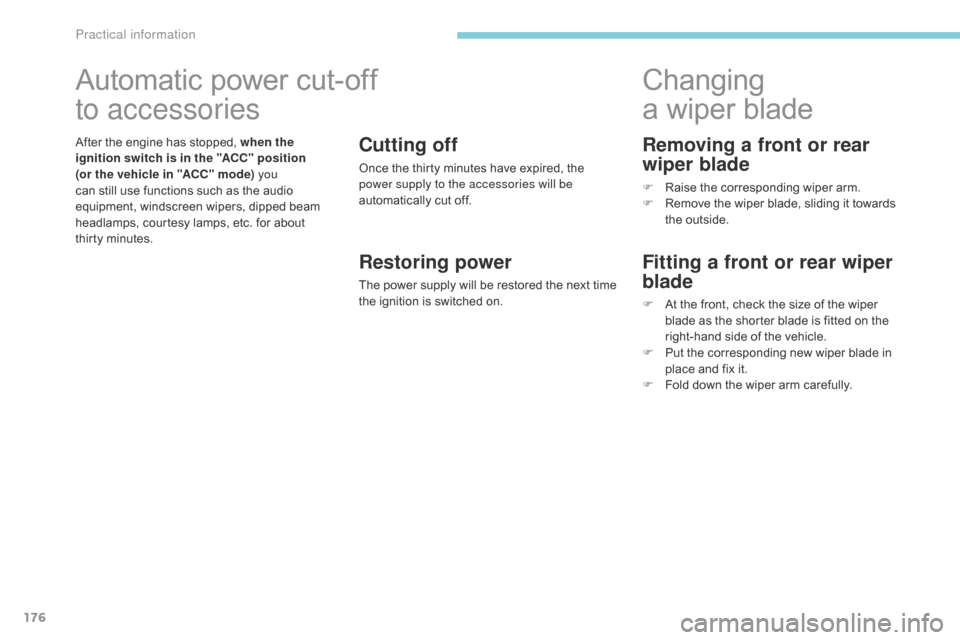
176
C4-Aircross_en_Chap07_info-pratiques_ed01-2016
Removing a front or rear
wiper blade
F Raise the corresponding wiper arm.
F R emove the wiper blade, sliding it towards
the outside.
Changing
a wiper blade
Fitting a front or rear wiper
blade
F At the front, check the size of the wiper
blade as the shorter blade is fitted on the
right-hand side of the vehicle.
F
P
ut the corresponding new wiper blade in
place and fix it.
F
F
old down the wiper arm carefully.
Automatic power cut-off
to accessories
After the engine has stopped, when the
ignition switch is in the "ACC" position
(or the vehicle in "ACC" mode) you
can still use functions such as the audio
equipment, windscreen wipers, dipped beam
headlamps,
courtesy lamps, etc. for about
thirty
m
inutes.Cutting off
Once the thirty minutes have expired, the
power supply to the accessories will be
automatically cut off.
Restoring power
The power supply will be restored the next time
the ignition is switched on.
Practical information
Page 179 of 368
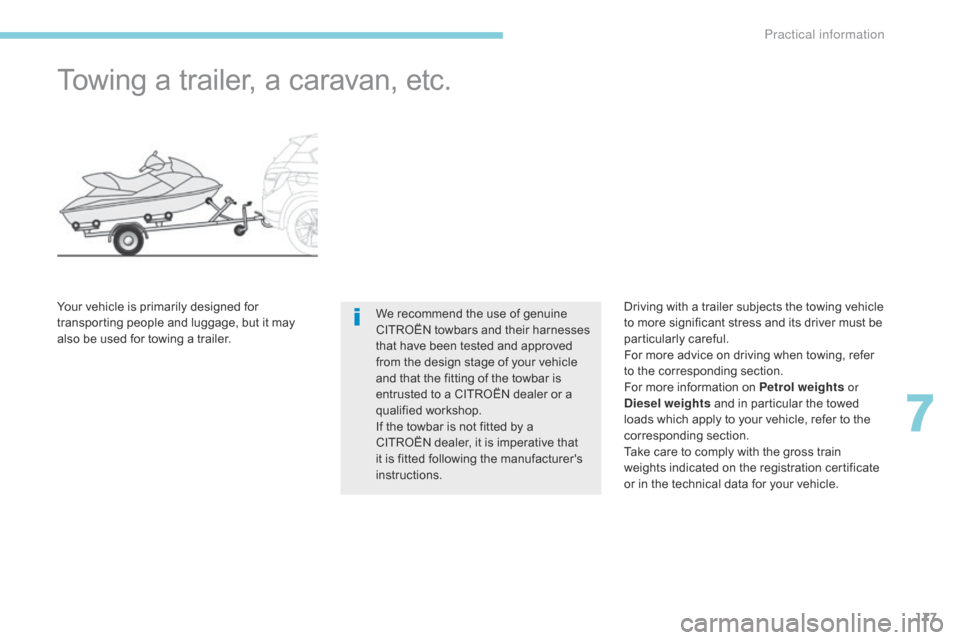
177
C4-Aircross_en_Chap07_info-pratiques_ed01-2016
Towing a trailer, a caravan, etc.
We recommend the use of genuine
CITROËN towbars and their harnesses
that have been tested and approved
from the design stage of your vehicle
and that the fitting of the towbar is
entrusted to a CITROËN dealer or a
qualified workshop.
If the towbar is not fitted by a
CITROËN dealer, it is imperative that
it is fitted following the manufacturer's
instructions.
Your vehicle is primarily designed for
transporting people and luggage, but it may
also be used for towing a trailer.
Driving with a trailer subjects the towing vehicle
to more significant stress and its driver must be
particularly careful.
For more advice on driving when towing, refer
to the corresponding section.
For more information on Petrol weights
or
Diesel weights and in particular the towed
loads which apply to your vehicle, refer to the
corresponding section.
Take care to comply with the gross train
weights indicated on the registration certificate
or in the technical data for your vehicle.
7
Practical information
Page 180 of 368
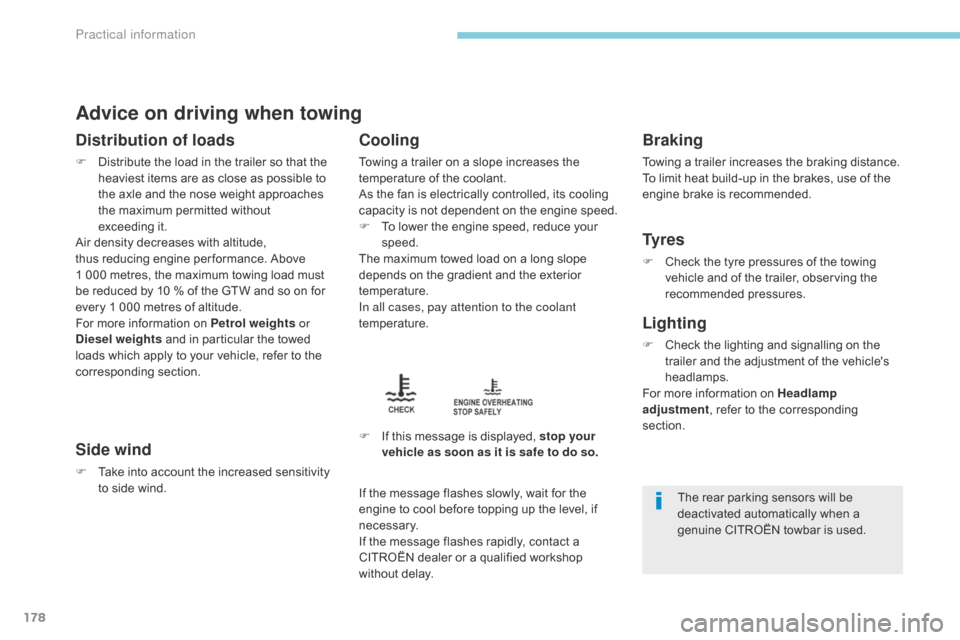
178
C4-Aircross_en_Chap07_info-pratiques_ed01-2016
Advice on driving when towing
Distribution of loads
F Distribute the load in the trailer so that the heaviest items are as close as possible to
the axle and the nose weight approaches
the maximum permitted without
exceeding
it.
Air density decreases with altitude,
thus
reducing engine per formance. Above
1
000 metres, the maximum towing load must
be reduced by 10
% of the GTW and so on for
every 1
000 metres of altitude.
For more information on Petrol weights or
Diesel weights and in particular the towed
loads which apply to your vehicle, refer to the
corresponding section.
Side wind
F Take into account the increased sensitivity to side wind.
Cooling
Towing a trailer on a slope increases the
temperature of the coolant.
As the fan is electrically controlled, its cooling
capacity is not dependent on the engine speed.
F
T
o lower the engine speed, reduce your
speed.
The maximum towed load on a long slope
depends on the gradient and the exterior
temperature.
In all cases, pay attention to the coolant
temperature.
F
I
f this message is displayed, stop your
vehicle as soon as it is safe to do so.
Braking
Towing a trailer increases the braking distance.
To limit heat build-up in the brakes, use of the
engine brake is recommended.
Ty r e s
F Check the tyre pressures of the towing vehicle and of the trailer, observing the
recommended pressures.
Lighting
F Check the lighting and signalling on the trailer and the adjustment of the vehicle's
headlamps.
For more information on Headlamp
adjustment , refer to the corresponding
section.
If the message flashes slowly, wait for the
engine to cool before topping up the level, if
necessary.
If the message flashes rapidly, contact a
CITROËN dealer or a qualified workshop
without delay.
The rear parking sensors will be
deactivated automatically when a
genuine CITROËN towbar is used.
Practical information